Developing Vision and Strategic Direction: Health Foundation
VerifiedAdded on 2019/12/17
|13
|4636
|160
Report
AI Summary
This report provides a comprehensive analysis of the Health Foundation's vision and strategic direction. It begins by examining the roles of key stakeholders in developing the vision, including providers, funding bodies, managers, and service users, and analyzes factors impacting the organization, such as political, economic, social, technological, and environmental factors. The report then outlines the Health Foundation's vision and mission statements and strategic goals, including enhancing service quality, improving health policies, and promoting overall population health. The report explores the methods used to communicate the vision within the organization, emphasizing the importance of inspiring leadership and two-way communication. It also discusses strategies for building support for the vision among employees and external stakeholders. Furthermore, the report delves into leadership behaviors that promote the vision, embedding the vision within the organization, translating the vision into organizational objectives, and the strategic planning process. The analysis highlights the importance of techniques such as key issue analysis, competitor analysis, and stakeholder analysis in assessing the organization's position, and value for money, impact analysis, and time budgeting in making appropriate choices.
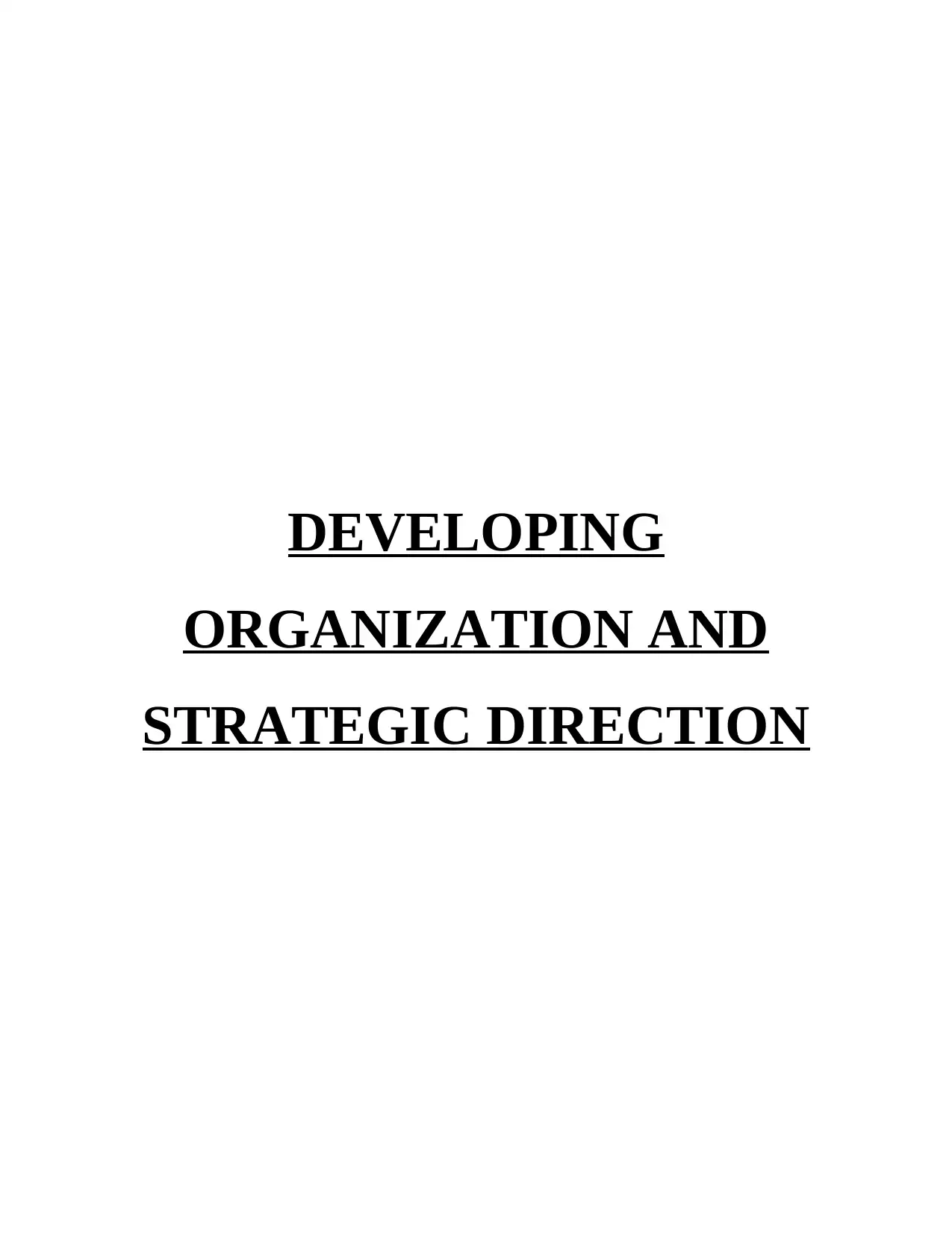
DEVELOPING
ORGANIZATION AND
STRATEGIC DIRECTION
ORGANIZATION AND
STRATEGIC DIRECTION
Paraphrase This Document
Need a fresh take? Get an instant paraphrase of this document with our AI Paraphraser
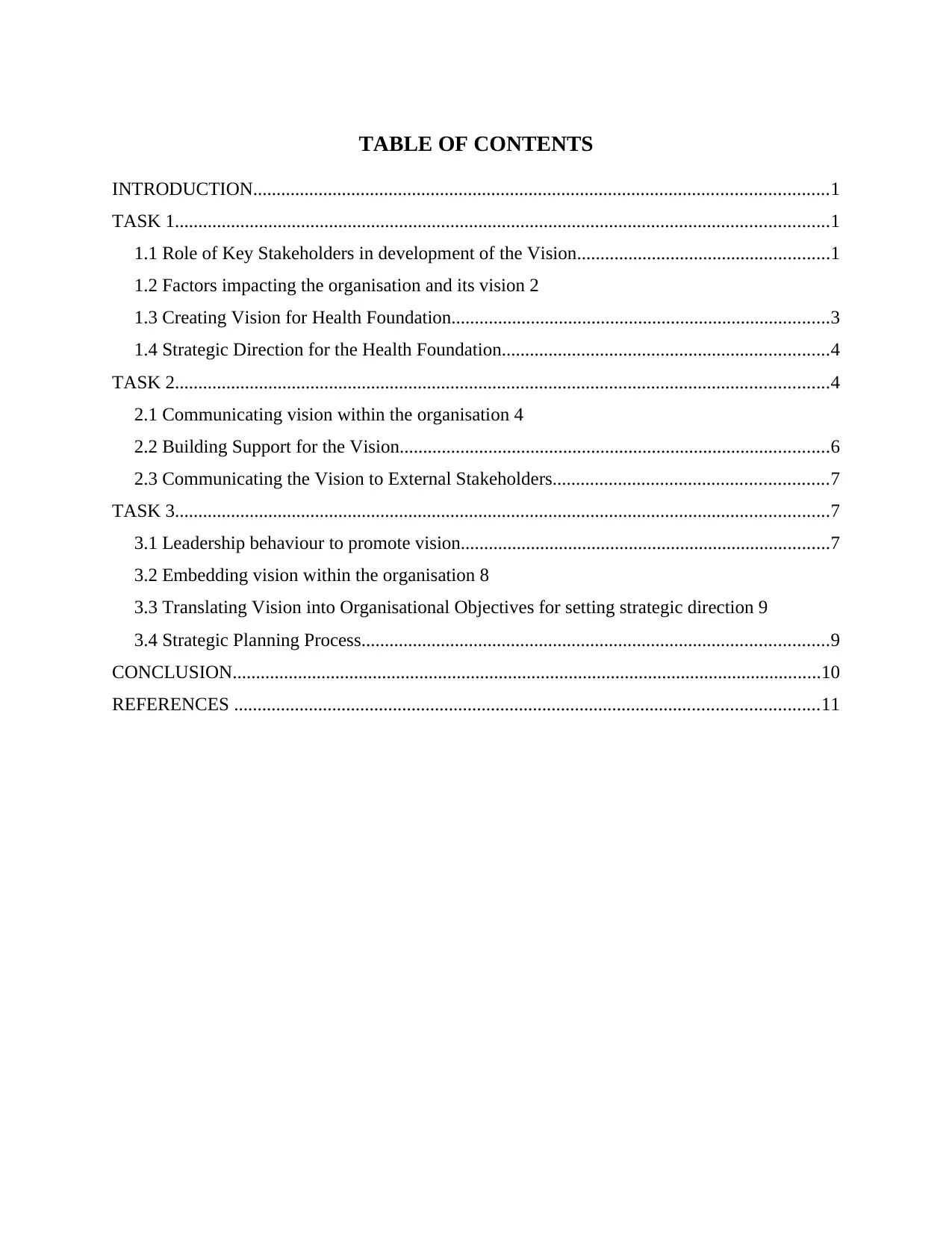
TABLE OF CONTENTS
INTRODUCTION...........................................................................................................................1
TASK 1............................................................................................................................................1
1.1 Role of Key Stakeholders in development of the Vision......................................................1
1.2 Factors impacting the organisation and its vision 2
1.3 Creating Vision for Health Foundation.................................................................................3
1.4 Strategic Direction for the Health Foundation......................................................................4
TASK 2............................................................................................................................................4
2.1 Communicating vision within the organisation 4
2.2 Building Support for the Vision............................................................................................6
2.3 Communicating the Vision to External Stakeholders...........................................................7
TASK 3............................................................................................................................................7
3.1 Leadership behaviour to promote vision...............................................................................7
3.2 Embedding vision within the organisation 8
3.3 Translating Vision into Organisational Objectives for setting strategic direction 9
3.4 Strategic Planning Process....................................................................................................9
CONCLUSION..............................................................................................................................10
REFERENCES .............................................................................................................................11
INTRODUCTION...........................................................................................................................1
TASK 1............................................................................................................................................1
1.1 Role of Key Stakeholders in development of the Vision......................................................1
1.2 Factors impacting the organisation and its vision 2
1.3 Creating Vision for Health Foundation.................................................................................3
1.4 Strategic Direction for the Health Foundation......................................................................4
TASK 2............................................................................................................................................4
2.1 Communicating vision within the organisation 4
2.2 Building Support for the Vision............................................................................................6
2.3 Communicating the Vision to External Stakeholders...........................................................7
TASK 3............................................................................................................................................7
3.1 Leadership behaviour to promote vision...............................................................................7
3.2 Embedding vision within the organisation 8
3.3 Translating Vision into Organisational Objectives for setting strategic direction 9
3.4 Strategic Planning Process....................................................................................................9
CONCLUSION..............................................................................................................................10
REFERENCES .............................................................................................................................11
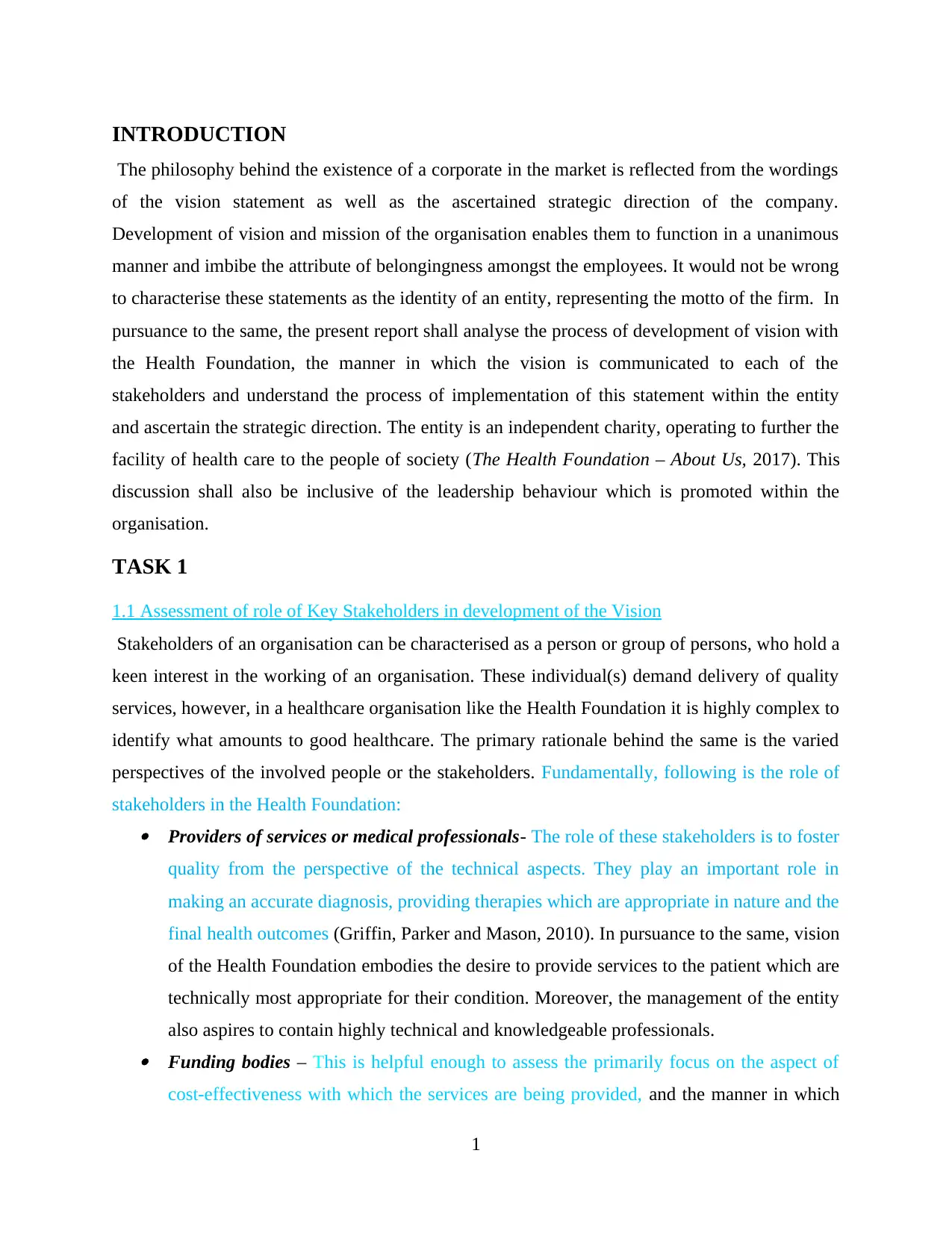
INTRODUCTION
The philosophy behind the existence of a corporate in the market is reflected from the wordings
of the vision statement as well as the ascertained strategic direction of the company.
Development of vision and mission of the organisation enables them to function in a unanimous
manner and imbibe the attribute of belongingness amongst the employees. It would not be wrong
to characterise these statements as the identity of an entity, representing the motto of the firm. In
pursuance to the same, the present report shall analyse the process of development of vision with
the Health Foundation, the manner in which the vision is communicated to each of the
stakeholders and understand the process of implementation of this statement within the entity
and ascertain the strategic direction. The entity is an independent charity, operating to further the
facility of health care to the people of society (The Health Foundation – About Us, 2017). This
discussion shall also be inclusive of the leadership behaviour which is promoted within the
organisation.
TASK 1
1.1 Assessment of role of Key Stakeholders in development of the Vision
Stakeholders of an organisation can be characterised as a person or group of persons, who hold a
keen interest in the working of an organisation. These individual(s) demand delivery of quality
services, however, in a healthcare organisation like the Health Foundation it is highly complex to
identify what amounts to good healthcare. The primary rationale behind the same is the varied
perspectives of the involved people or the stakeholders. Fundamentally, following is the role of
stakeholders in the Health Foundation: Providers of services or medical professionals- The role of these stakeholders is to foster
quality from the perspective of the technical aspects. They play an important role in
making an accurate diagnosis, providing therapies which are appropriate in nature and the
final health outcomes (Griffin, Parker and Mason, 2010). In pursuance to the same, vision
of the Health Foundation embodies the desire to provide services to the patient which are
technically most appropriate for their condition. Moreover, the management of the entity
also aspires to contain highly technical and knowledgeable professionals. Funding bodies – This is helpful enough to assess the primarily focus on the aspect of
cost-effectiveness with which the services are being provided, and the manner in which
1
The philosophy behind the existence of a corporate in the market is reflected from the wordings
of the vision statement as well as the ascertained strategic direction of the company.
Development of vision and mission of the organisation enables them to function in a unanimous
manner and imbibe the attribute of belongingness amongst the employees. It would not be wrong
to characterise these statements as the identity of an entity, representing the motto of the firm. In
pursuance to the same, the present report shall analyse the process of development of vision with
the Health Foundation, the manner in which the vision is communicated to each of the
stakeholders and understand the process of implementation of this statement within the entity
and ascertain the strategic direction. The entity is an independent charity, operating to further the
facility of health care to the people of society (The Health Foundation – About Us, 2017). This
discussion shall also be inclusive of the leadership behaviour which is promoted within the
organisation.
TASK 1
1.1 Assessment of role of Key Stakeholders in development of the Vision
Stakeholders of an organisation can be characterised as a person or group of persons, who hold a
keen interest in the working of an organisation. These individual(s) demand delivery of quality
services, however, in a healthcare organisation like the Health Foundation it is highly complex to
identify what amounts to good healthcare. The primary rationale behind the same is the varied
perspectives of the involved people or the stakeholders. Fundamentally, following is the role of
stakeholders in the Health Foundation: Providers of services or medical professionals- The role of these stakeholders is to foster
quality from the perspective of the technical aspects. They play an important role in
making an accurate diagnosis, providing therapies which are appropriate in nature and the
final health outcomes (Griffin, Parker and Mason, 2010). In pursuance to the same, vision
of the Health Foundation embodies the desire to provide services to the patient which are
technically most appropriate for their condition. Moreover, the management of the entity
also aspires to contain highly technical and knowledgeable professionals. Funding bodies – This is helpful enough to assess the primarily focus on the aspect of
cost-effectiveness with which the services are being provided, and the manner in which
1
⊘ This is a preview!⊘
Do you want full access?
Subscribe today to unlock all pages.

Trusted by 1+ million students worldwide
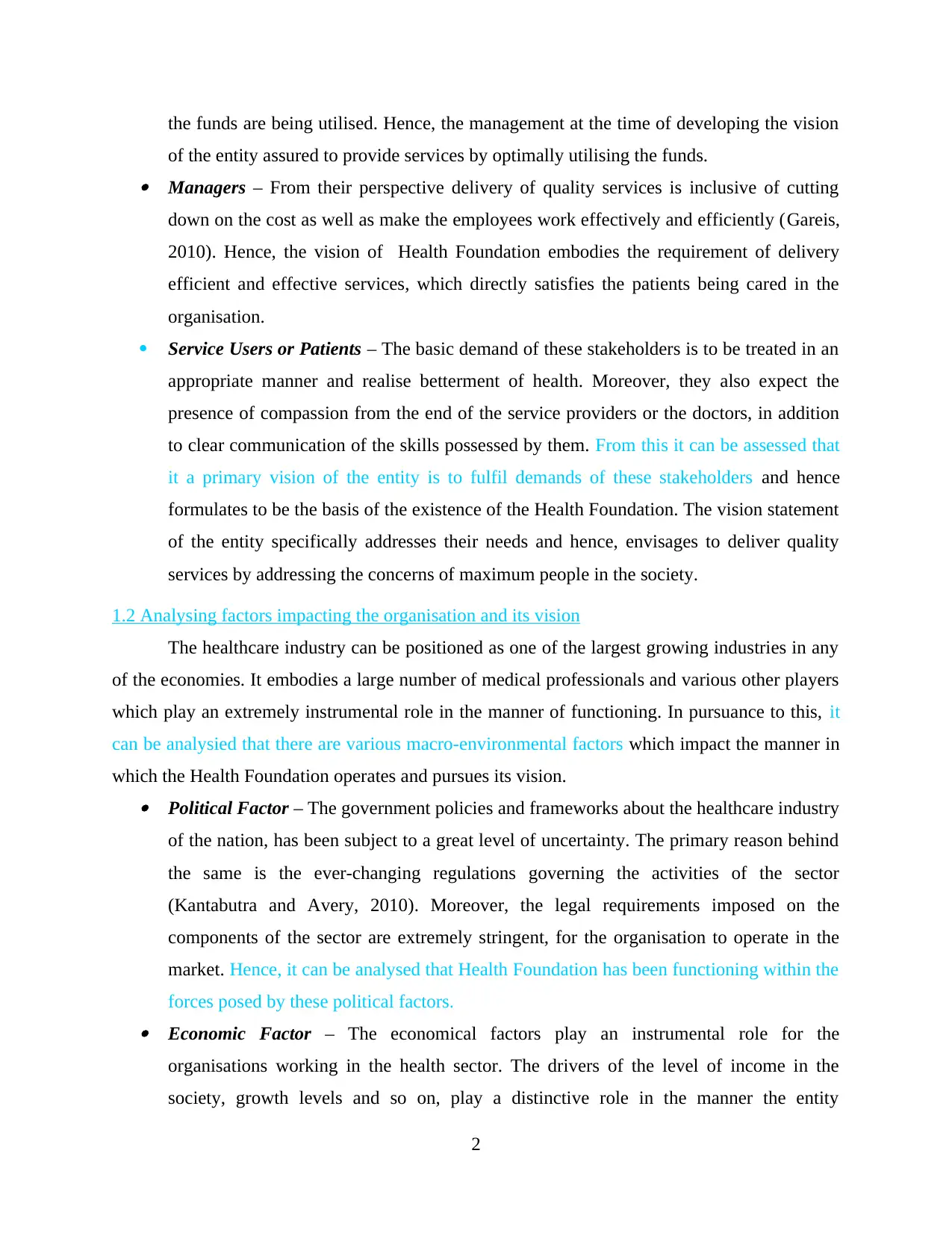
the funds are being utilised. Hence, the management at the time of developing the vision
of the entity assured to provide services by optimally utilising the funds. Managers – From their perspective delivery of quality services is inclusive of cutting
down on the cost as well as make the employees work effectively and efficiently (Gareis,
2010). Hence, the vision of Health Foundation embodies the requirement of delivery
efficient and effective services, which directly satisfies the patients being cared in the
organisation.
Service Users or Patients – The basic demand of these stakeholders is to be treated in an
appropriate manner and realise betterment of health. Moreover, they also expect the
presence of compassion from the end of the service providers or the doctors, in addition
to clear communication of the skills possessed by them. From this it can be assessed that
it a primary vision of the entity is to fulfil demands of these stakeholders and hence
formulates to be the basis of the existence of the Health Foundation. The vision statement
of the entity specifically addresses their needs and hence, envisages to deliver quality
services by addressing the concerns of maximum people in the society.
1.2 Analysing factors impacting the organisation and its vision
The healthcare industry can be positioned as one of the largest growing industries in any
of the economies. It embodies a large number of medical professionals and various other players
which play an extremely instrumental role in the manner of functioning. In pursuance to this, it
can be analysied that there are various macro-environmental factors which impact the manner in
which the Health Foundation operates and pursues its vision. Political Factor – The government policies and frameworks about the healthcare industry
of the nation, has been subject to a great level of uncertainty. The primary reason behind
the same is the ever-changing regulations governing the activities of the sector
(Kantabutra and Avery, 2010). Moreover, the legal requirements imposed on the
components of the sector are extremely stringent, for the organisation to operate in the
market. Hence, it can be analysed that Health Foundation has been functioning within the
forces posed by these political factors. Economic Factor – The economical factors play an instrumental role for the
organisations working in the health sector. The drivers of the level of income in the
society, growth levels and so on, play a distinctive role in the manner the entity
2
of the entity assured to provide services by optimally utilising the funds. Managers – From their perspective delivery of quality services is inclusive of cutting
down on the cost as well as make the employees work effectively and efficiently (Gareis,
2010). Hence, the vision of Health Foundation embodies the requirement of delivery
efficient and effective services, which directly satisfies the patients being cared in the
organisation.
Service Users or Patients – The basic demand of these stakeholders is to be treated in an
appropriate manner and realise betterment of health. Moreover, they also expect the
presence of compassion from the end of the service providers or the doctors, in addition
to clear communication of the skills possessed by them. From this it can be assessed that
it a primary vision of the entity is to fulfil demands of these stakeholders and hence
formulates to be the basis of the existence of the Health Foundation. The vision statement
of the entity specifically addresses their needs and hence, envisages to deliver quality
services by addressing the concerns of maximum people in the society.
1.2 Analysing factors impacting the organisation and its vision
The healthcare industry can be positioned as one of the largest growing industries in any
of the economies. It embodies a large number of medical professionals and various other players
which play an extremely instrumental role in the manner of functioning. In pursuance to this, it
can be analysied that there are various macro-environmental factors which impact the manner in
which the Health Foundation operates and pursues its vision. Political Factor – The government policies and frameworks about the healthcare industry
of the nation, has been subject to a great level of uncertainty. The primary reason behind
the same is the ever-changing regulations governing the activities of the sector
(Kantabutra and Avery, 2010). Moreover, the legal requirements imposed on the
components of the sector are extremely stringent, for the organisation to operate in the
market. Hence, it can be analysed that Health Foundation has been functioning within the
forces posed by these political factors. Economic Factor – The economical factors play an instrumental role for the
organisations working in the health sector. The drivers of the level of income in the
society, growth levels and so on, play a distinctive role in the manner the entity
2
Paraphrase This Document
Need a fresh take? Get an instant paraphrase of this document with our AI Paraphraser
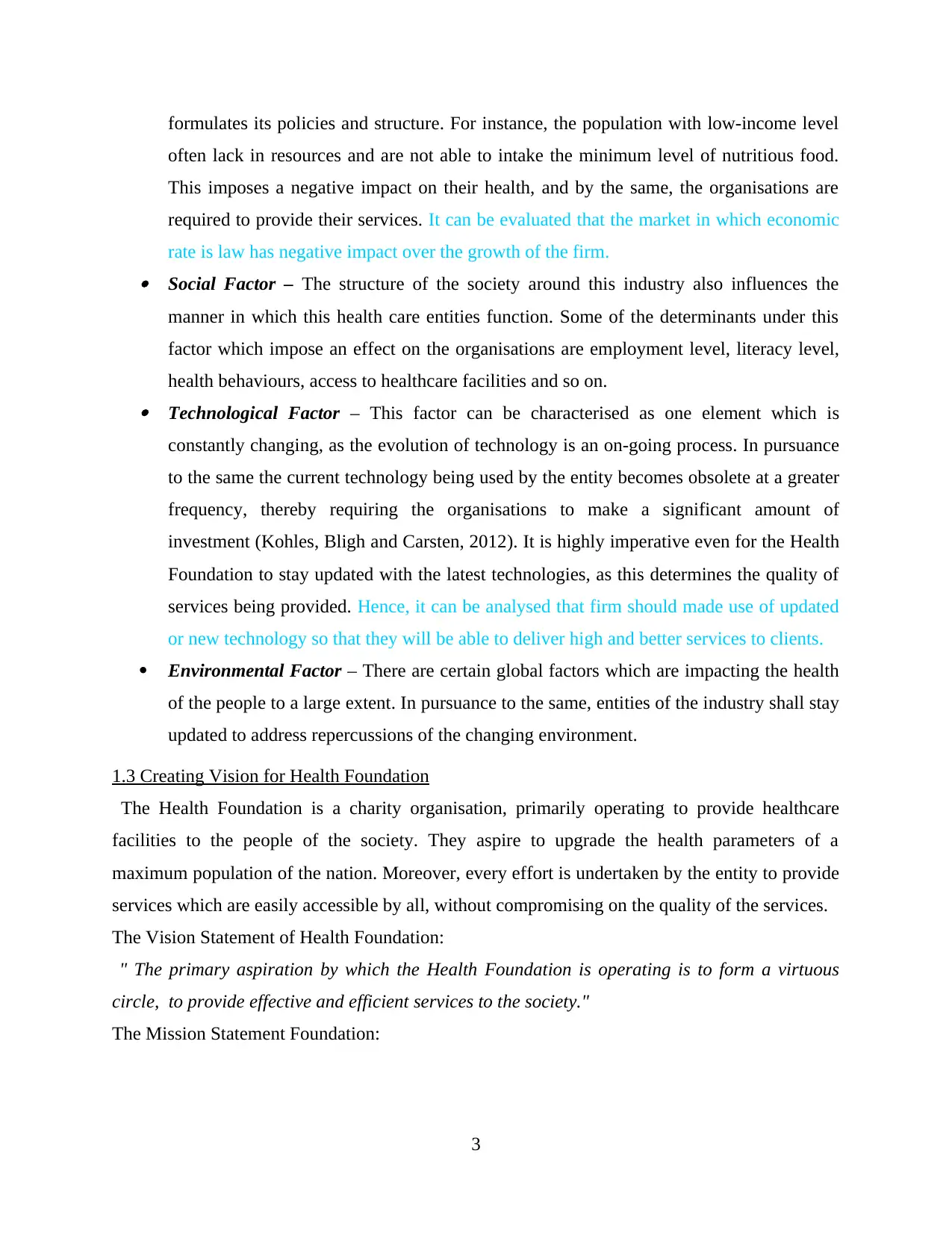
formulates its policies and structure. For instance, the population with low-income level
often lack in resources and are not able to intake the minimum level of nutritious food.
This imposes a negative impact on their health, and by the same, the organisations are
required to provide their services. It can be evaluated that the market in which economic
rate is law has negative impact over the growth of the firm. Social Factor – The structure of the society around this industry also influences the
manner in which this health care entities function. Some of the determinants under this
factor which impose an effect on the organisations are employment level, literacy level,
health behaviours, access to healthcare facilities and so on. Technological Factor – This factor can be characterised as one element which is
constantly changing, as the evolution of technology is an on-going process. In pursuance
to the same the current technology being used by the entity becomes obsolete at a greater
frequency, thereby requiring the organisations to make a significant amount of
investment (Kohles, Bligh and Carsten, 2012). It is highly imperative even for the Health
Foundation to stay updated with the latest technologies, as this determines the quality of
services being provided. Hence, it can be analysed that firm should made use of updated
or new technology so that they will be able to deliver high and better services to clients.
Environmental Factor – There are certain global factors which are impacting the health
of the people to a large extent. In pursuance to the same, entities of the industry shall stay
updated to address repercussions of the changing environment.
1.3 Creating Vision for Health Foundation
The Health Foundation is a charity organisation, primarily operating to provide healthcare
facilities to the people of the society. They aspire to upgrade the health parameters of a
maximum population of the nation. Moreover, every effort is undertaken by the entity to provide
services which are easily accessible by all, without compromising on the quality of the services.
The Vision Statement of Health Foundation:
" The primary aspiration by which the Health Foundation is operating is to form a virtuous
circle, to provide effective and efficient services to the society."
The Mission Statement Foundation:
3
often lack in resources and are not able to intake the minimum level of nutritious food.
This imposes a negative impact on their health, and by the same, the organisations are
required to provide their services. It can be evaluated that the market in which economic
rate is law has negative impact over the growth of the firm. Social Factor – The structure of the society around this industry also influences the
manner in which this health care entities function. Some of the determinants under this
factor which impose an effect on the organisations are employment level, literacy level,
health behaviours, access to healthcare facilities and so on. Technological Factor – This factor can be characterised as one element which is
constantly changing, as the evolution of technology is an on-going process. In pursuance
to the same the current technology being used by the entity becomes obsolete at a greater
frequency, thereby requiring the organisations to make a significant amount of
investment (Kohles, Bligh and Carsten, 2012). It is highly imperative even for the Health
Foundation to stay updated with the latest technologies, as this determines the quality of
services being provided. Hence, it can be analysed that firm should made use of updated
or new technology so that they will be able to deliver high and better services to clients.
Environmental Factor – There are certain global factors which are impacting the health
of the people to a large extent. In pursuance to the same, entities of the industry shall stay
updated to address repercussions of the changing environment.
1.3 Creating Vision for Health Foundation
The Health Foundation is a charity organisation, primarily operating to provide healthcare
facilities to the people of the society. They aspire to upgrade the health parameters of a
maximum population of the nation. Moreover, every effort is undertaken by the entity to provide
services which are easily accessible by all, without compromising on the quality of the services.
The Vision Statement of Health Foundation:
" The primary aspiration by which the Health Foundation is operating is to form a virtuous
circle, to provide effective and efficient services to the society."
The Mission Statement Foundation:
3
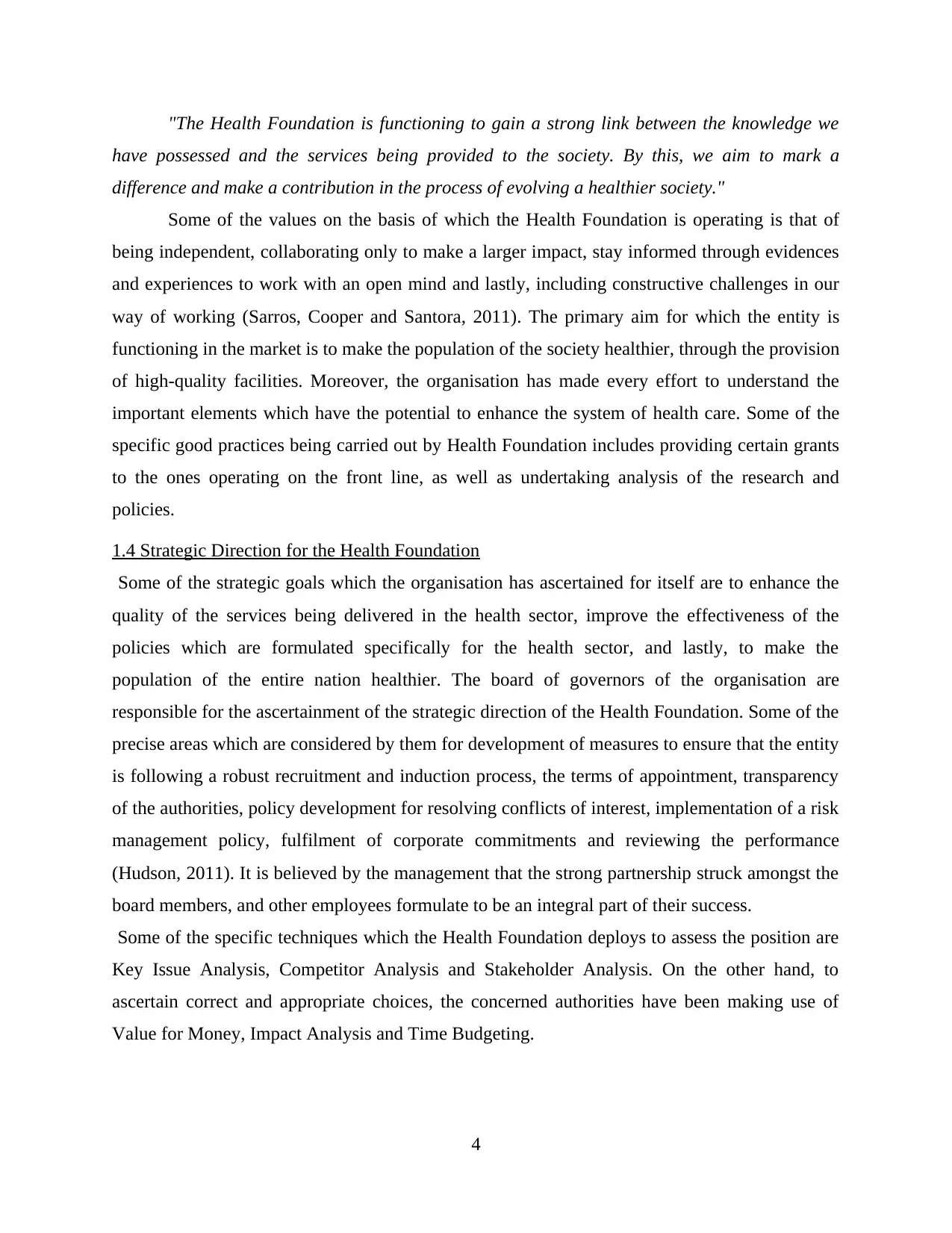
"The Health Foundation is functioning to gain a strong link between the knowledge we
have possessed and the services being provided to the society. By this, we aim to mark a
difference and make a contribution in the process of evolving a healthier society."
Some of the values on the basis of which the Health Foundation is operating is that of
being independent, collaborating only to make a larger impact, stay informed through evidences
and experiences to work with an open mind and lastly, including constructive challenges in our
way of working (Sarros, Cooper and Santora, 2011). The primary aim for which the entity is
functioning in the market is to make the population of the society healthier, through the provision
of high-quality facilities. Moreover, the organisation has made every effort to understand the
important elements which have the potential to enhance the system of health care. Some of the
specific good practices being carried out by Health Foundation includes providing certain grants
to the ones operating on the front line, as well as undertaking analysis of the research and
policies.
1.4 Strategic Direction for the Health Foundation
Some of the strategic goals which the organisation has ascertained for itself are to enhance the
quality of the services being delivered in the health sector, improve the effectiveness of the
policies which are formulated specifically for the health sector, and lastly, to make the
population of the entire nation healthier. The board of governors of the organisation are
responsible for the ascertainment of the strategic direction of the Health Foundation. Some of the
precise areas which are considered by them for development of measures to ensure that the entity
is following a robust recruitment and induction process, the terms of appointment, transparency
of the authorities, policy development for resolving conflicts of interest, implementation of a risk
management policy, fulfilment of corporate commitments and reviewing the performance
(Hudson, 2011). It is believed by the management that the strong partnership struck amongst the
board members, and other employees formulate to be an integral part of their success.
Some of the specific techniques which the Health Foundation deploys to assess the position are
Key Issue Analysis, Competitor Analysis and Stakeholder Analysis. On the other hand, to
ascertain correct and appropriate choices, the concerned authorities have been making use of
Value for Money, Impact Analysis and Time Budgeting.
4
have possessed and the services being provided to the society. By this, we aim to mark a
difference and make a contribution in the process of evolving a healthier society."
Some of the values on the basis of which the Health Foundation is operating is that of
being independent, collaborating only to make a larger impact, stay informed through evidences
and experiences to work with an open mind and lastly, including constructive challenges in our
way of working (Sarros, Cooper and Santora, 2011). The primary aim for which the entity is
functioning in the market is to make the population of the society healthier, through the provision
of high-quality facilities. Moreover, the organisation has made every effort to understand the
important elements which have the potential to enhance the system of health care. Some of the
specific good practices being carried out by Health Foundation includes providing certain grants
to the ones operating on the front line, as well as undertaking analysis of the research and
policies.
1.4 Strategic Direction for the Health Foundation
Some of the strategic goals which the organisation has ascertained for itself are to enhance the
quality of the services being delivered in the health sector, improve the effectiveness of the
policies which are formulated specifically for the health sector, and lastly, to make the
population of the entire nation healthier. The board of governors of the organisation are
responsible for the ascertainment of the strategic direction of the Health Foundation. Some of the
precise areas which are considered by them for development of measures to ensure that the entity
is following a robust recruitment and induction process, the terms of appointment, transparency
of the authorities, policy development for resolving conflicts of interest, implementation of a risk
management policy, fulfilment of corporate commitments and reviewing the performance
(Hudson, 2011). It is believed by the management that the strong partnership struck amongst the
board members, and other employees formulate to be an integral part of their success.
Some of the specific techniques which the Health Foundation deploys to assess the position are
Key Issue Analysis, Competitor Analysis and Stakeholder Analysis. On the other hand, to
ascertain correct and appropriate choices, the concerned authorities have been making use of
Value for Money, Impact Analysis and Time Budgeting.
4
⊘ This is a preview!⊘
Do you want full access?
Subscribe today to unlock all pages.

Trusted by 1+ million students worldwide
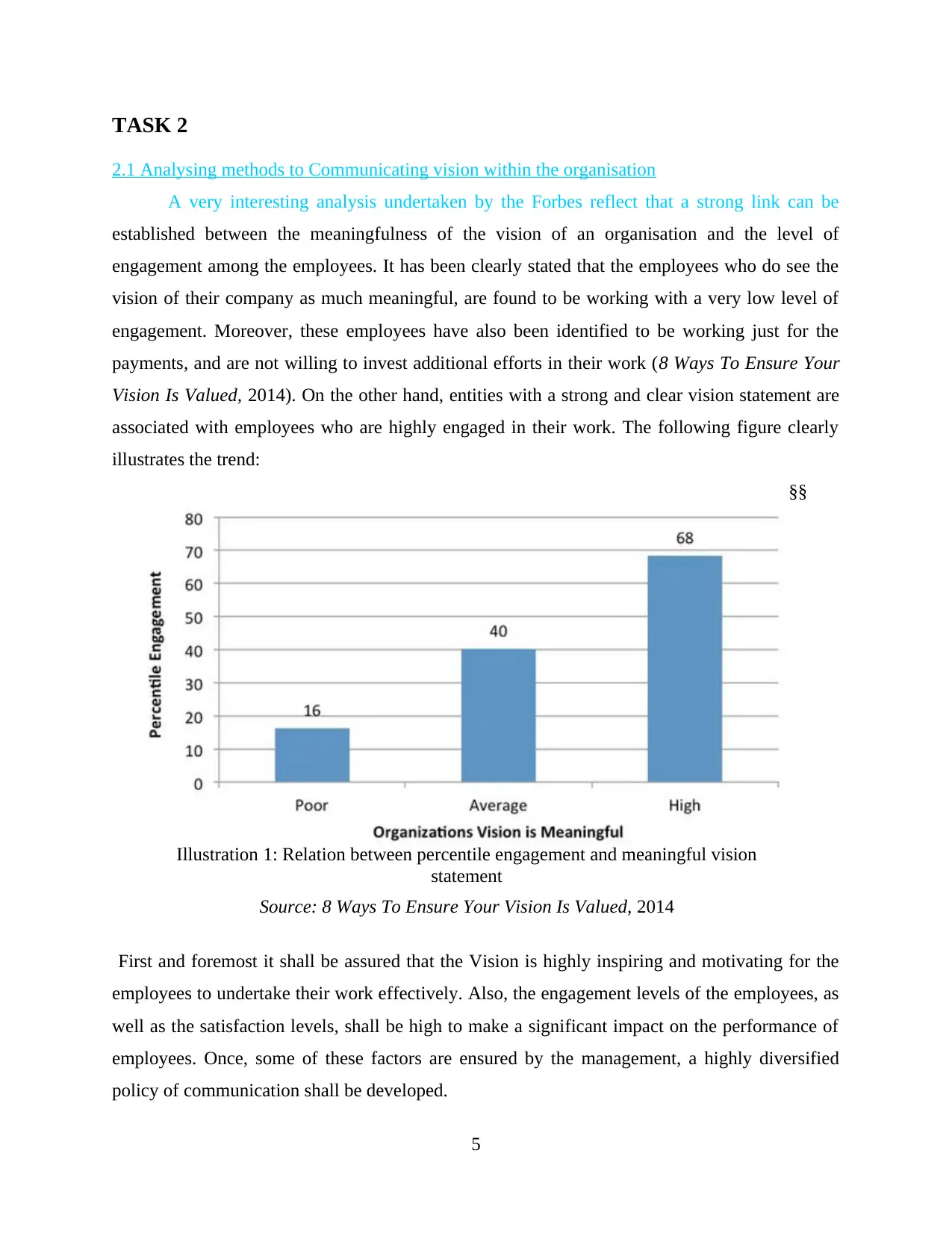
TASK 2
2.1 Analysing methods to Communicating vision within the organisation
A very interesting analysis undertaken by the Forbes reflect that a strong link can be
established between the meaningfulness of the vision of an organisation and the level of
engagement among the employees. It has been clearly stated that the employees who do see the
vision of their company as much meaningful, are found to be working with a very low level of
engagement. Moreover, these employees have also been identified to be working just for the
payments, and are not willing to invest additional efforts in their work (8 Ways To Ensure Your
Vision Is Valued, 2014). On the other hand, entities with a strong and clear vision statement are
associated with employees who are highly engaged in their work. The following figure clearly
illustrates the trend:
Illustration 1: Relation between percentile engagement and meaningful vision
statement
Source: 8 Ways To Ensure Your Vision Is Valued, 2014
§§
First and foremost it shall be assured that the Vision is highly inspiring and motivating for the
employees to undertake their work effectively. Also, the engagement levels of the employees, as
well as the satisfaction levels, shall be high to make a significant impact on the performance of
employees. Once, some of these factors are ensured by the management, a highly diversified
policy of communication shall be developed.
5
2.1 Analysing methods to Communicating vision within the organisation
A very interesting analysis undertaken by the Forbes reflect that a strong link can be
established between the meaningfulness of the vision of an organisation and the level of
engagement among the employees. It has been clearly stated that the employees who do see the
vision of their company as much meaningful, are found to be working with a very low level of
engagement. Moreover, these employees have also been identified to be working just for the
payments, and are not willing to invest additional efforts in their work (8 Ways To Ensure Your
Vision Is Valued, 2014). On the other hand, entities with a strong and clear vision statement are
associated with employees who are highly engaged in their work. The following figure clearly
illustrates the trend:
Illustration 1: Relation between percentile engagement and meaningful vision
statement
Source: 8 Ways To Ensure Your Vision Is Valued, 2014
§§
First and foremost it shall be assured that the Vision is highly inspiring and motivating for the
employees to undertake their work effectively. Also, the engagement levels of the employees, as
well as the satisfaction levels, shall be high to make a significant impact on the performance of
employees. Once, some of these factors are ensured by the management, a highly diversified
policy of communication shall be developed.
5
Paraphrase This Document
Need a fresh take? Get an instant paraphrase of this document with our AI Paraphraser
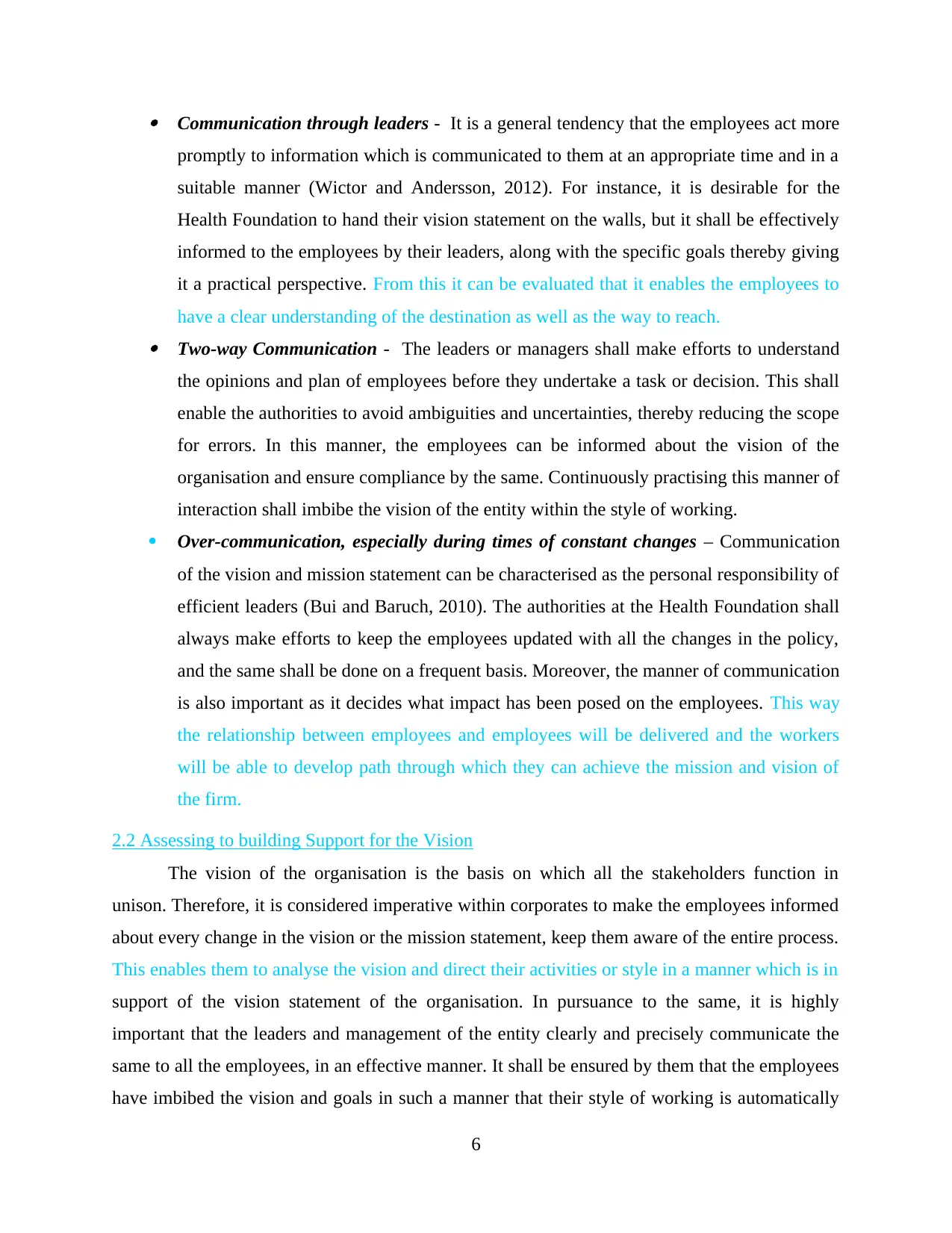
Communication through leaders - It is a general tendency that the employees act more
promptly to information which is communicated to them at an appropriate time and in a
suitable manner (Wictor and Andersson, 2012). For instance, it is desirable for the
Health Foundation to hand their vision statement on the walls, but it shall be effectively
informed to the employees by their leaders, along with the specific goals thereby giving
it a practical perspective. From this it can be evaluated that it enables the employees to
have a clear understanding of the destination as well as the way to reach. Two-way Communication - The leaders or managers shall make efforts to understand
the opinions and plan of employees before they undertake a task or decision. This shall
enable the authorities to avoid ambiguities and uncertainties, thereby reducing the scope
for errors. In this manner, the employees can be informed about the vision of the
organisation and ensure compliance by the same. Continuously practising this manner of
interaction shall imbibe the vision of the entity within the style of working.
Over-communication, especially during times of constant changes – Communication
of the vision and mission statement can be characterised as the personal responsibility of
efficient leaders (Bui and Baruch, 2010). The authorities at the Health Foundation shall
always make efforts to keep the employees updated with all the changes in the policy,
and the same shall be done on a frequent basis. Moreover, the manner of communication
is also important as it decides what impact has been posed on the employees. This way
the relationship between employees and employees will be delivered and the workers
will be able to develop path through which they can achieve the mission and vision of
the firm.
2.2 Assessing to building Support for the Vision
The vision of the organisation is the basis on which all the stakeholders function in
unison. Therefore, it is considered imperative within corporates to make the employees informed
about every change in the vision or the mission statement, keep them aware of the entire process.
This enables them to analyse the vision and direct their activities or style in a manner which is in
support of the vision statement of the organisation. In pursuance to the same, it is highly
important that the leaders and management of the entity clearly and precisely communicate the
same to all the employees, in an effective manner. It shall be ensured by them that the employees
have imbibed the vision and goals in such a manner that their style of working is automatically
6
promptly to information which is communicated to them at an appropriate time and in a
suitable manner (Wictor and Andersson, 2012). For instance, it is desirable for the
Health Foundation to hand their vision statement on the walls, but it shall be effectively
informed to the employees by their leaders, along with the specific goals thereby giving
it a practical perspective. From this it can be evaluated that it enables the employees to
have a clear understanding of the destination as well as the way to reach. Two-way Communication - The leaders or managers shall make efforts to understand
the opinions and plan of employees before they undertake a task or decision. This shall
enable the authorities to avoid ambiguities and uncertainties, thereby reducing the scope
for errors. In this manner, the employees can be informed about the vision of the
organisation and ensure compliance by the same. Continuously practising this manner of
interaction shall imbibe the vision of the entity within the style of working.
Over-communication, especially during times of constant changes – Communication
of the vision and mission statement can be characterised as the personal responsibility of
efficient leaders (Bui and Baruch, 2010). The authorities at the Health Foundation shall
always make efforts to keep the employees updated with all the changes in the policy,
and the same shall be done on a frequent basis. Moreover, the manner of communication
is also important as it decides what impact has been posed on the employees. This way
the relationship between employees and employees will be delivered and the workers
will be able to develop path through which they can achieve the mission and vision of
the firm.
2.2 Assessing to building Support for the Vision
The vision of the organisation is the basis on which all the stakeholders function in
unison. Therefore, it is considered imperative within corporates to make the employees informed
about every change in the vision or the mission statement, keep them aware of the entire process.
This enables them to analyse the vision and direct their activities or style in a manner which is in
support of the vision statement of the organisation. In pursuance to the same, it is highly
important that the leaders and management of the entity clearly and precisely communicate the
same to all the employees, in an effective manner. It shall be ensured by them that the employees
have imbibed the vision and goals in such a manner that their style of working is automatically
6
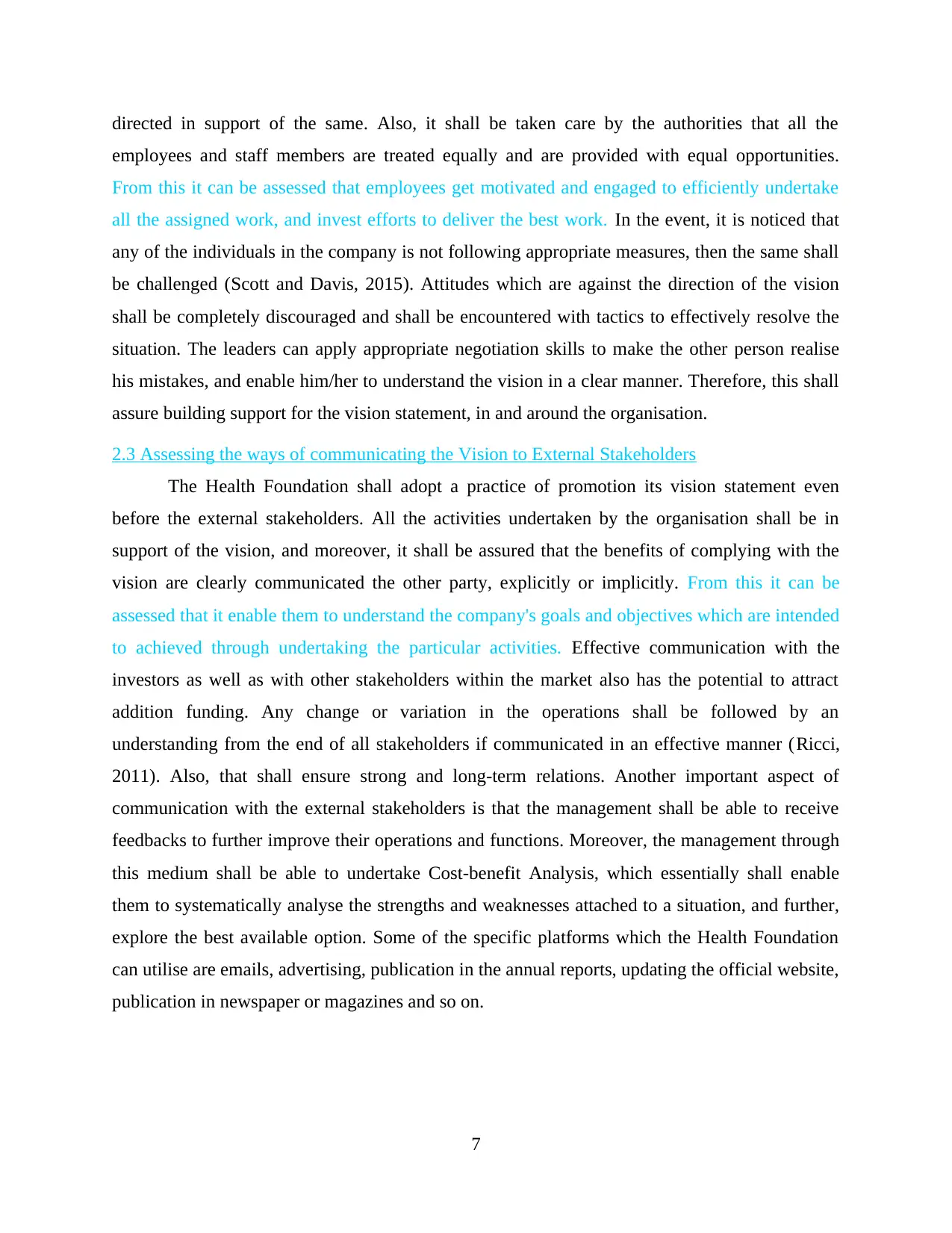
directed in support of the same. Also, it shall be taken care by the authorities that all the
employees and staff members are treated equally and are provided with equal opportunities.
From this it can be assessed that employees get motivated and engaged to efficiently undertake
all the assigned work, and invest efforts to deliver the best work. In the event, it is noticed that
any of the individuals in the company is not following appropriate measures, then the same shall
be challenged (Scott and Davis, 2015). Attitudes which are against the direction of the vision
shall be completely discouraged and shall be encountered with tactics to effectively resolve the
situation. The leaders can apply appropriate negotiation skills to make the other person realise
his mistakes, and enable him/her to understand the vision in a clear manner. Therefore, this shall
assure building support for the vision statement, in and around the organisation.
2.3 Assessing the ways of communicating the Vision to External Stakeholders
The Health Foundation shall adopt a practice of promotion its vision statement even
before the external stakeholders. All the activities undertaken by the organisation shall be in
support of the vision, and moreover, it shall be assured that the benefits of complying with the
vision are clearly communicated the other party, explicitly or implicitly. From this it can be
assessed that it enable them to understand the company's goals and objectives which are intended
to achieved through undertaking the particular activities. Effective communication with the
investors as well as with other stakeholders within the market also has the potential to attract
addition funding. Any change or variation in the operations shall be followed by an
understanding from the end of all stakeholders if communicated in an effective manner (Ricci,
2011). Also, that shall ensure strong and long-term relations. Another important aspect of
communication with the external stakeholders is that the management shall be able to receive
feedbacks to further improve their operations and functions. Moreover, the management through
this medium shall be able to undertake Cost-benefit Analysis, which essentially shall enable
them to systematically analyse the strengths and weaknesses attached to a situation, and further,
explore the best available option. Some of the specific platforms which the Health Foundation
can utilise are emails, advertising, publication in the annual reports, updating the official website,
publication in newspaper or magazines and so on.
7
employees and staff members are treated equally and are provided with equal opportunities.
From this it can be assessed that employees get motivated and engaged to efficiently undertake
all the assigned work, and invest efforts to deliver the best work. In the event, it is noticed that
any of the individuals in the company is not following appropriate measures, then the same shall
be challenged (Scott and Davis, 2015). Attitudes which are against the direction of the vision
shall be completely discouraged and shall be encountered with tactics to effectively resolve the
situation. The leaders can apply appropriate negotiation skills to make the other person realise
his mistakes, and enable him/her to understand the vision in a clear manner. Therefore, this shall
assure building support for the vision statement, in and around the organisation.
2.3 Assessing the ways of communicating the Vision to External Stakeholders
The Health Foundation shall adopt a practice of promotion its vision statement even
before the external stakeholders. All the activities undertaken by the organisation shall be in
support of the vision, and moreover, it shall be assured that the benefits of complying with the
vision are clearly communicated the other party, explicitly or implicitly. From this it can be
assessed that it enable them to understand the company's goals and objectives which are intended
to achieved through undertaking the particular activities. Effective communication with the
investors as well as with other stakeholders within the market also has the potential to attract
addition funding. Any change or variation in the operations shall be followed by an
understanding from the end of all stakeholders if communicated in an effective manner (Ricci,
2011). Also, that shall ensure strong and long-term relations. Another important aspect of
communication with the external stakeholders is that the management shall be able to receive
feedbacks to further improve their operations and functions. Moreover, the management through
this medium shall be able to undertake Cost-benefit Analysis, which essentially shall enable
them to systematically analyse the strengths and weaknesses attached to a situation, and further,
explore the best available option. Some of the specific platforms which the Health Foundation
can utilise are emails, advertising, publication in the annual reports, updating the official website,
publication in newspaper or magazines and so on.
7
⊘ This is a preview!⊘
Do you want full access?
Subscribe today to unlock all pages.

Trusted by 1+ million students worldwide
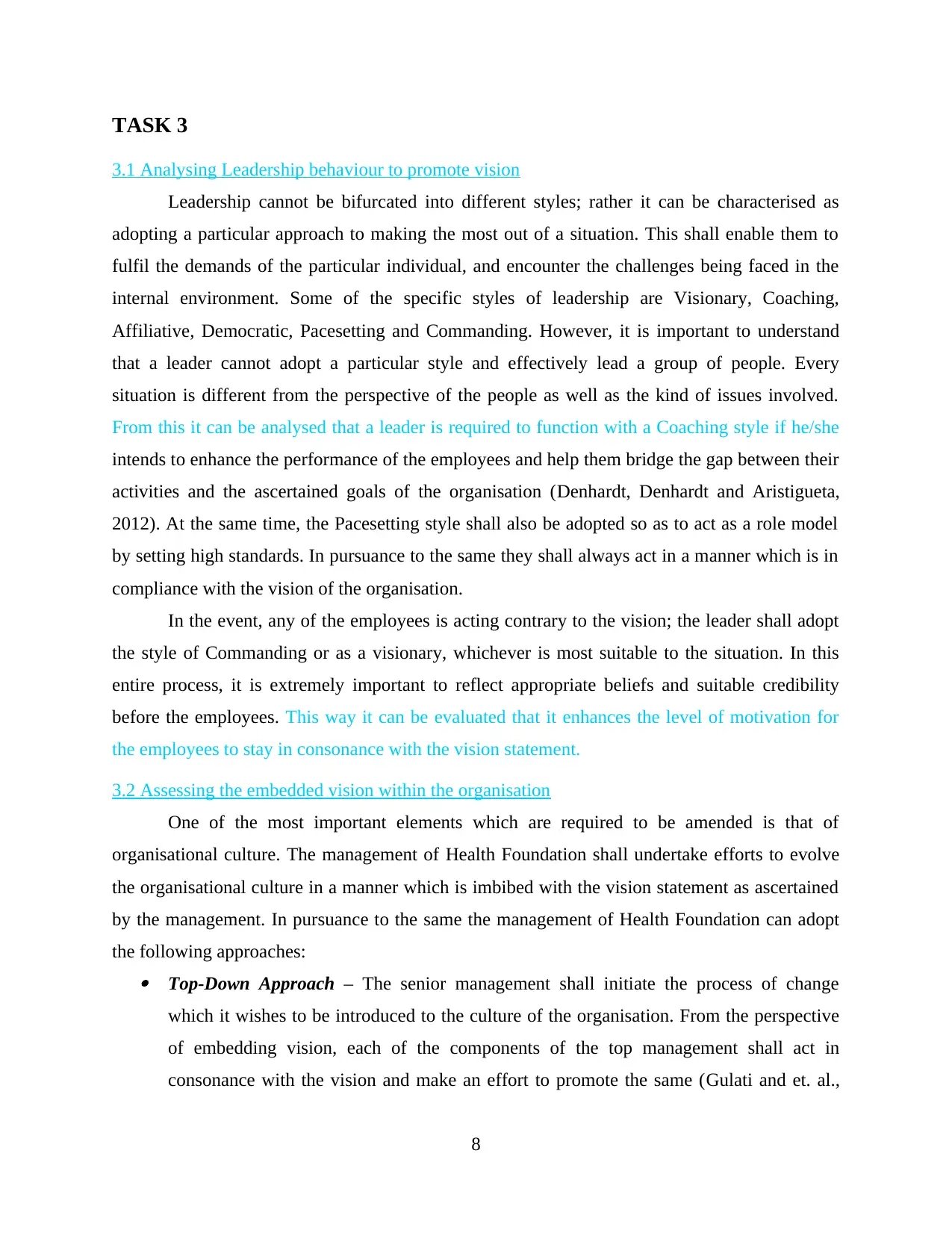
TASK 3
3.1 Analysing Leadership behaviour to promote vision
Leadership cannot be bifurcated into different styles; rather it can be characterised as
adopting a particular approach to making the most out of a situation. This shall enable them to
fulfil the demands of the particular individual, and encounter the challenges being faced in the
internal environment. Some of the specific styles of leadership are Visionary, Coaching,
Affiliative, Democratic, Pacesetting and Commanding. However, it is important to understand
that a leader cannot adopt a particular style and effectively lead a group of people. Every
situation is different from the perspective of the people as well as the kind of issues involved.
From this it can be analysed that a leader is required to function with a Coaching style if he/she
intends to enhance the performance of the employees and help them bridge the gap between their
activities and the ascertained goals of the organisation (Denhardt, Denhardt and Aristigueta,
2012). At the same time, the Pacesetting style shall also be adopted so as to act as a role model
by setting high standards. In pursuance to the same they shall always act in a manner which is in
compliance with the vision of the organisation.
In the event, any of the employees is acting contrary to the vision; the leader shall adopt
the style of Commanding or as a visionary, whichever is most suitable to the situation. In this
entire process, it is extremely important to reflect appropriate beliefs and suitable credibility
before the employees. This way it can be evaluated that it enhances the level of motivation for
the employees to stay in consonance with the vision statement.
3.2 Assessing the embedded vision within the organisation
One of the most important elements which are required to be amended is that of
organisational culture. The management of Health Foundation shall undertake efforts to evolve
the organisational culture in a manner which is imbibed with the vision statement as ascertained
by the management. In pursuance to the same the management of Health Foundation can adopt
the following approaches: Top-Down Approach – The senior management shall initiate the process of change
which it wishes to be introduced to the culture of the organisation. From the perspective
of embedding vision, each of the components of the top management shall act in
consonance with the vision and make an effort to promote the same (Gulati and et. al.,
8
3.1 Analysing Leadership behaviour to promote vision
Leadership cannot be bifurcated into different styles; rather it can be characterised as
adopting a particular approach to making the most out of a situation. This shall enable them to
fulfil the demands of the particular individual, and encounter the challenges being faced in the
internal environment. Some of the specific styles of leadership are Visionary, Coaching,
Affiliative, Democratic, Pacesetting and Commanding. However, it is important to understand
that a leader cannot adopt a particular style and effectively lead a group of people. Every
situation is different from the perspective of the people as well as the kind of issues involved.
From this it can be analysed that a leader is required to function with a Coaching style if he/she
intends to enhance the performance of the employees and help them bridge the gap between their
activities and the ascertained goals of the organisation (Denhardt, Denhardt and Aristigueta,
2012). At the same time, the Pacesetting style shall also be adopted so as to act as a role model
by setting high standards. In pursuance to the same they shall always act in a manner which is in
compliance with the vision of the organisation.
In the event, any of the employees is acting contrary to the vision; the leader shall adopt
the style of Commanding or as a visionary, whichever is most suitable to the situation. In this
entire process, it is extremely important to reflect appropriate beliefs and suitable credibility
before the employees. This way it can be evaluated that it enhances the level of motivation for
the employees to stay in consonance with the vision statement.
3.2 Assessing the embedded vision within the organisation
One of the most important elements which are required to be amended is that of
organisational culture. The management of Health Foundation shall undertake efforts to evolve
the organisational culture in a manner which is imbibed with the vision statement as ascertained
by the management. In pursuance to the same the management of Health Foundation can adopt
the following approaches: Top-Down Approach – The senior management shall initiate the process of change
which it wishes to be introduced to the culture of the organisation. From the perspective
of embedding vision, each of the components of the top management shall act in
consonance with the vision and make an effort to promote the same (Gulati and et. al.,
8
Paraphrase This Document
Need a fresh take? Get an instant paraphrase of this document with our AI Paraphraser
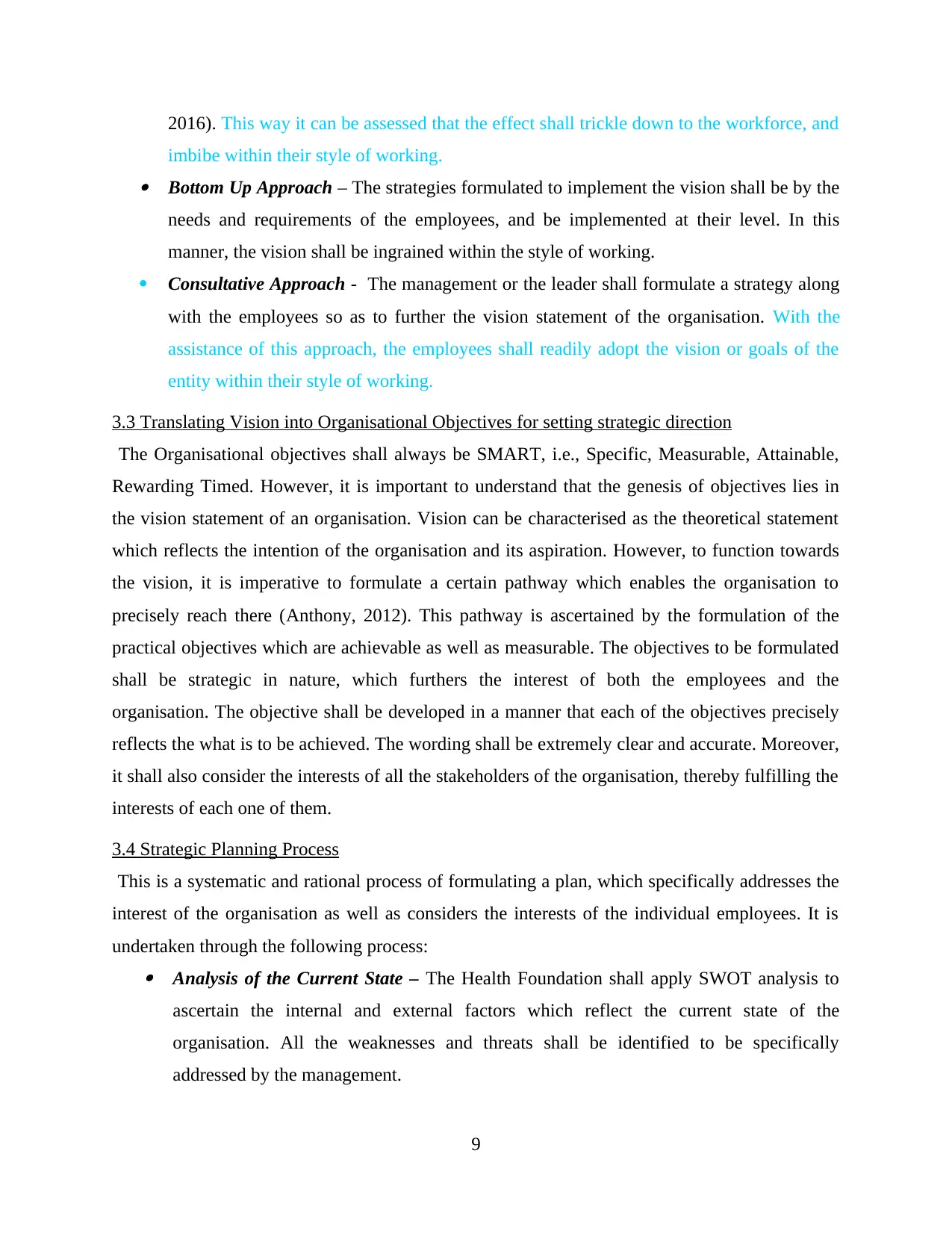
2016). This way it can be assessed that the effect shall trickle down to the workforce, and
imbibe within their style of working. Bottom Up Approach – The strategies formulated to implement the vision shall be by the
needs and requirements of the employees, and be implemented at their level. In this
manner, the vision shall be ingrained within the style of working.
Consultative Approach - The management or the leader shall formulate a strategy along
with the employees so as to further the vision statement of the organisation. With the
assistance of this approach, the employees shall readily adopt the vision or goals of the
entity within their style of working.
3.3 Translating Vision into Organisational Objectives for setting strategic direction
The Organisational objectives shall always be SMART, i.e., Specific, Measurable, Attainable,
Rewarding Timed. However, it is important to understand that the genesis of objectives lies in
the vision statement of an organisation. Vision can be characterised as the theoretical statement
which reflects the intention of the organisation and its aspiration. However, to function towards
the vision, it is imperative to formulate a certain pathway which enables the organisation to
precisely reach there (Anthony, 2012). This pathway is ascertained by the formulation of the
practical objectives which are achievable as well as measurable. The objectives to be formulated
shall be strategic in nature, which furthers the interest of both the employees and the
organisation. The objective shall be developed in a manner that each of the objectives precisely
reflects the what is to be achieved. The wording shall be extremely clear and accurate. Moreover,
it shall also consider the interests of all the stakeholders of the organisation, thereby fulfilling the
interests of each one of them.
3.4 Strategic Planning Process
This is a systematic and rational process of formulating a plan, which specifically addresses the
interest of the organisation as well as considers the interests of the individual employees. It is
undertaken through the following process: Analysis of the Current State – The Health Foundation shall apply SWOT analysis to
ascertain the internal and external factors which reflect the current state of the
organisation. All the weaknesses and threats shall be identified to be specifically
addressed by the management.
9
imbibe within their style of working. Bottom Up Approach – The strategies formulated to implement the vision shall be by the
needs and requirements of the employees, and be implemented at their level. In this
manner, the vision shall be ingrained within the style of working.
Consultative Approach - The management or the leader shall formulate a strategy along
with the employees so as to further the vision statement of the organisation. With the
assistance of this approach, the employees shall readily adopt the vision or goals of the
entity within their style of working.
3.3 Translating Vision into Organisational Objectives for setting strategic direction
The Organisational objectives shall always be SMART, i.e., Specific, Measurable, Attainable,
Rewarding Timed. However, it is important to understand that the genesis of objectives lies in
the vision statement of an organisation. Vision can be characterised as the theoretical statement
which reflects the intention of the organisation and its aspiration. However, to function towards
the vision, it is imperative to formulate a certain pathway which enables the organisation to
precisely reach there (Anthony, 2012). This pathway is ascertained by the formulation of the
practical objectives which are achievable as well as measurable. The objectives to be formulated
shall be strategic in nature, which furthers the interest of both the employees and the
organisation. The objective shall be developed in a manner that each of the objectives precisely
reflects the what is to be achieved. The wording shall be extremely clear and accurate. Moreover,
it shall also consider the interests of all the stakeholders of the organisation, thereby fulfilling the
interests of each one of them.
3.4 Strategic Planning Process
This is a systematic and rational process of formulating a plan, which specifically addresses the
interest of the organisation as well as considers the interests of the individual employees. It is
undertaken through the following process: Analysis of the Current State – The Health Foundation shall apply SWOT analysis to
ascertain the internal and external factors which reflect the current state of the
organisation. All the weaknesses and threats shall be identified to be specifically
addressed by the management.
9
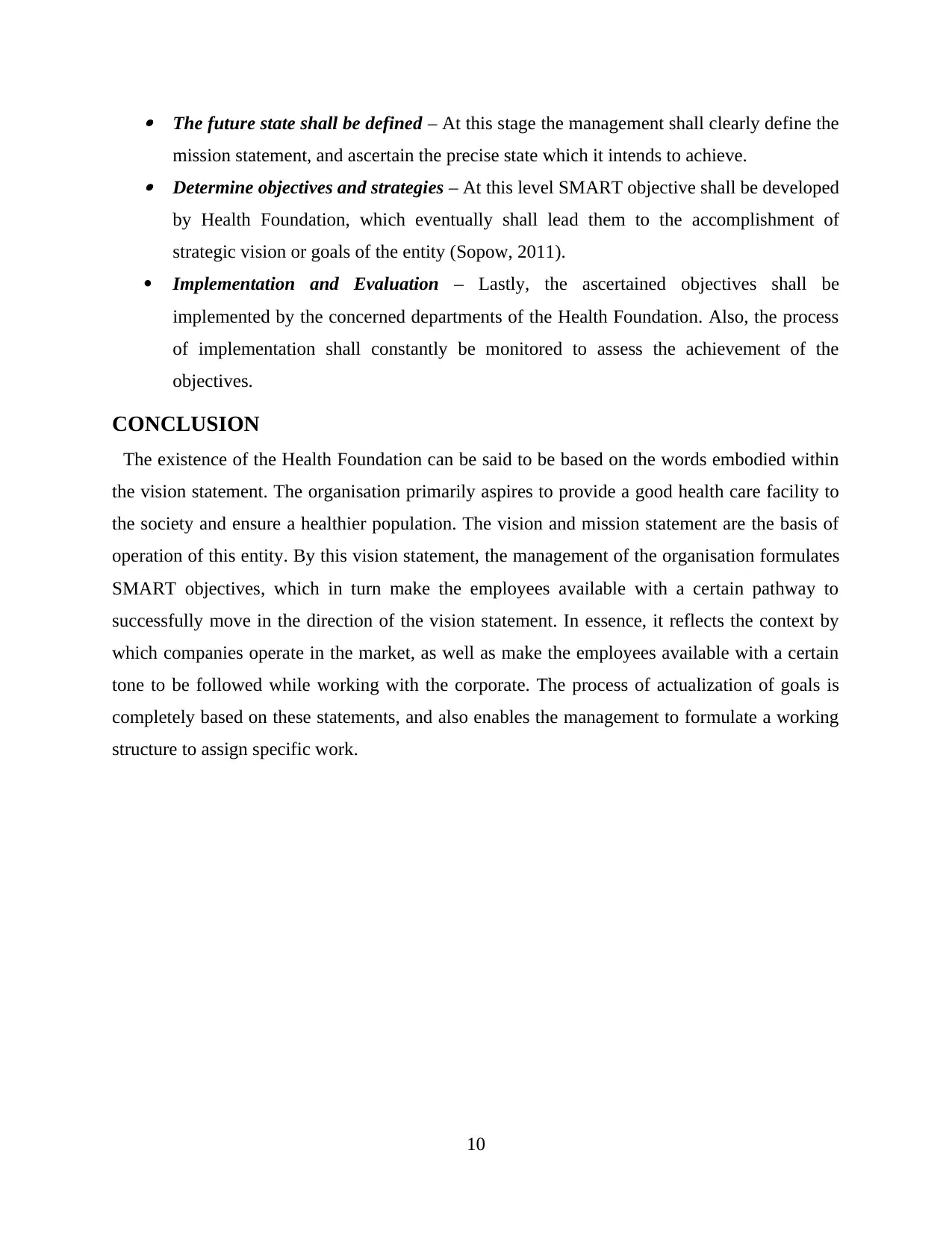
The future state shall be defined – At this stage the management shall clearly define the
mission statement, and ascertain the precise state which it intends to achieve. Determine objectives and strategies – At this level SMART objective shall be developed
by Health Foundation, which eventually shall lead them to the accomplishment of
strategic vision or goals of the entity (Sopow, 2011).
Implementation and Evaluation – Lastly, the ascertained objectives shall be
implemented by the concerned departments of the Health Foundation. Also, the process
of implementation shall constantly be monitored to assess the achievement of the
objectives.
CONCLUSION
The existence of the Health Foundation can be said to be based on the words embodied within
the vision statement. The organisation primarily aspires to provide a good health care facility to
the society and ensure a healthier population. The vision and mission statement are the basis of
operation of this entity. By this vision statement, the management of the organisation formulates
SMART objectives, which in turn make the employees available with a certain pathway to
successfully move in the direction of the vision statement. In essence, it reflects the context by
which companies operate in the market, as well as make the employees available with a certain
tone to be followed while working with the corporate. The process of actualization of goals is
completely based on these statements, and also enables the management to formulate a working
structure to assign specific work.
10
mission statement, and ascertain the precise state which it intends to achieve. Determine objectives and strategies – At this level SMART objective shall be developed
by Health Foundation, which eventually shall lead them to the accomplishment of
strategic vision or goals of the entity (Sopow, 2011).
Implementation and Evaluation – Lastly, the ascertained objectives shall be
implemented by the concerned departments of the Health Foundation. Also, the process
of implementation shall constantly be monitored to assess the achievement of the
objectives.
CONCLUSION
The existence of the Health Foundation can be said to be based on the words embodied within
the vision statement. The organisation primarily aspires to provide a good health care facility to
the society and ensure a healthier population. The vision and mission statement are the basis of
operation of this entity. By this vision statement, the management of the organisation formulates
SMART objectives, which in turn make the employees available with a certain pathway to
successfully move in the direction of the vision statement. In essence, it reflects the context by
which companies operate in the market, as well as make the employees available with a certain
tone to be followed while working with the corporate. The process of actualization of goals is
completely based on these statements, and also enables the management to formulate a working
structure to assign specific work.
10
⊘ This is a preview!⊘
Do you want full access?
Subscribe today to unlock all pages.

Trusted by 1+ million students worldwide
1 out of 13
Related Documents
Your All-in-One AI-Powered Toolkit for Academic Success.
+13062052269
info@desklib.com
Available 24*7 on WhatsApp / Email
![[object Object]](/_next/static/media/star-bottom.7253800d.svg)
Unlock your academic potential
Copyright © 2020–2025 A2Z Services. All Rights Reserved. Developed and managed by ZUCOL.





